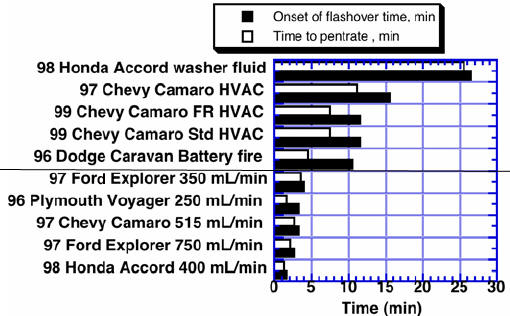|
|
Propagation Time
Test Measurements
Published research contains reports of controlled tests in which the time for fire propagation is recorded. Each provides an example of fire propagation under the given conditions. Frequently, the methods of ignition used are not representative, and thus the results may be difficult to generalize. Even when representative ignition is achieved, there are a numerous factors that can influence the time to propagate that are difficult to identify in real-world events (such as wind speed and direction, quantity of material leaking in fluid events, and resistance in electrical shorts). Still the published tests provide insight and information as to what is possible under the conditions shown.
In the following test sequence, the vehicles were first crash tested at a General Motors facility, and then taken to FM Global for instrumented burn tests. In the crash tests, vehicles were impacted with deformable moving barriers at approximately 50 mph and 65 mph for rear and front, respectively [1]. A more detailed description of each of the burn tests can be found on a table previously shown in this section by clicking here.
These tests show a clear distinction in propagation time between gasoline pool fires and engine compartment fires; pool fires propagate to the interior much faster. “Flashover time” is the time from fire ignition to flashover in the passenger compartment.
|
Test # |
Vehicle |
Flashover Time (min) |
| Rear Crashed Vehicles, Gasoline Fires Started Under the Vehicle in the Rear, leak rates shown | ||
| 8 |
98 Honda Accord #201 |
1.6 |
| 5 |
97 Ford
Explorer #188 |
2.6 |
| 3 |
97 Chevy
Camaro #158 |
3.3 |
| 2 |
96
Plymouth Voyager #143 |
3.3 |
| 6a |
97 Ford Explorer #18-9 |
4.0 |
|
Front Crashed Vehicles, Fires Started in the Engine Compartment |
||
| 1 |
96 Dodge
Caravan #119 |
10.5 |
| 9 |
99 Chevy
Camaro #190 |
11.5 |
| 10 |
99 Chevy
Camaro #190 |
11.5 |
| 4 |
97 Chevy
Camaro #178 |
15.5 |
| 7 |
98 Honda
Accord #203 |
26.5 |
 This bar graph shows the same series of tests tabulated above [1]. The vehicles subject to rear crash tests and pool fires are shown below the dividing line. |
The next burn tests shown (in the following table) involved fires initiated by igniting pans of heptane (a major component of gasoline) in the engine compartment. A small difference in time to propagate was observed between the tests, one of which had the HVAC fan on [2].
| Vehicle | Initiation Locations | Smoke to Pass.
Compartment (minutes) |
Fire to Passenger
Compartment (minutes) |
Conditions |
| Saab 9000 | 2/3 from front to bulkhead
(400 ml heptane each side) |
8:45 | 10:05 | Ventilation fan off |
| Saab 9000 | 2/3 from front to bulkhead (400 ml heptane each side) |
8:00 | Ventilation fan on. Fan shorted at 5:30 |
In the following test, a pan of heptane was ignited in the passenger compartment, with observations as to the spread to other areas of the vehicle [3].
| Vehicle | Initiation Location | Propagation |
| Ford Taurus | 1.5 liters heptane in open tray under LF seat, ignited. LF door ajar, windows partially open. | Immediate temperature rise in passenger compartment, increase in engine compartment ~15 minutes, increase in trunk ~10 min. |
Another set of tests were performed to quantify the rate of flame spread in buses. For these, full-size seats were installed in enclosed models of regions of a bus. The seats were then ignited in the manners identified below. One of the researchers [4] noted that the results were dependent on the size and shape of the compartments used for testing. Without full-scale vehicle tests, the results could still be used to make comparisons between seat materials as to their relative tendency to propagate fire.
Braun & Klote, 1991 [4]
Seats installed in model enclosures
Ignition to seats: Gas burner, 100 KW flame
Incapacitation in 2-3 minutes with some seat assemblies
Nelson & Bridgman, 1977 [5]
Enclosure with seats, comparison of materials
Ignition of newspaper
Flashover in 6-7 minutes
Consideration of more than one material necessary
References
Tewarson, A., et al., "Post Collision Motor Vehicle Fires," Prepared for Motor Vehicle Fire Research Institute, October 2005.
Johansson, E., “Investigation of Fire in Cars,” Saab-Scania AB, Sweden, International Technical Conference on Experimental Safety Vehicles, 12th, volume I, Washington, D.C., NHTSA, 1989.
Mangs, J., Keski-Rahkonen, O., “Characterization of the Fire Behavior of a Burning Passenger Car. Part I: Car Fire Experiments”, Fire Safety Journal, 23, 17-35, 1994.
Braun, E., et al., "An Assessment Methodology for the Fire Performance of School Bus Interior Components, Fire Safety Science, Third International Symposium, 1991.
Nelson, G., et al., "Material Performance in Transportation Vehicle Interiors," Journal of Fire and Flammability, Vol. 8, July, 1977.
|
|
|